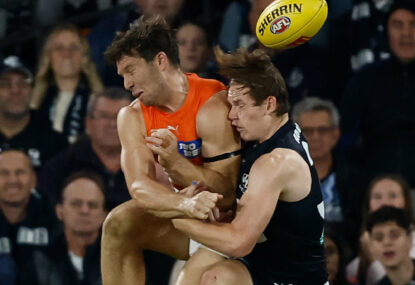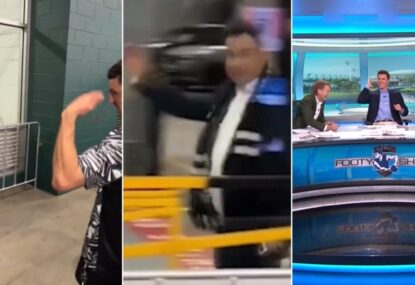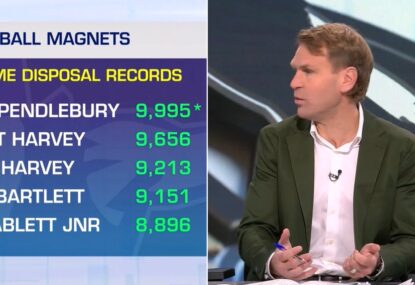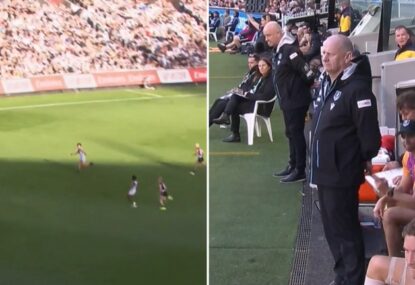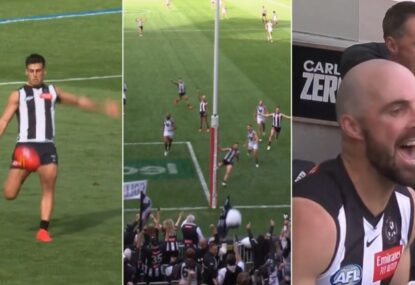Twenty years ago, I ran a Collingwood fan site called The Collingwood Rant.
We had a handful of columnists, polls, match previews and various other novelties. I would write match reviews and other Collingwood-related stuff a couple of times a week.
After losing successive grand finals in 2002 and ’03, Collingwood had a miserable 2004 and ’05. Around that time, I came up with a saying for those occasions Collingwood frustrated me: Collingwood shits me, or simply the acronym CSM. Some people picked up on it and use it to this day. You might’ve seen it on social media, under the hashtag #csm.
A fanatical Collingwood stalwart, the Turtle, recently asked me for my top ten CSM moments.
That’s an interesting one. There have been so many.
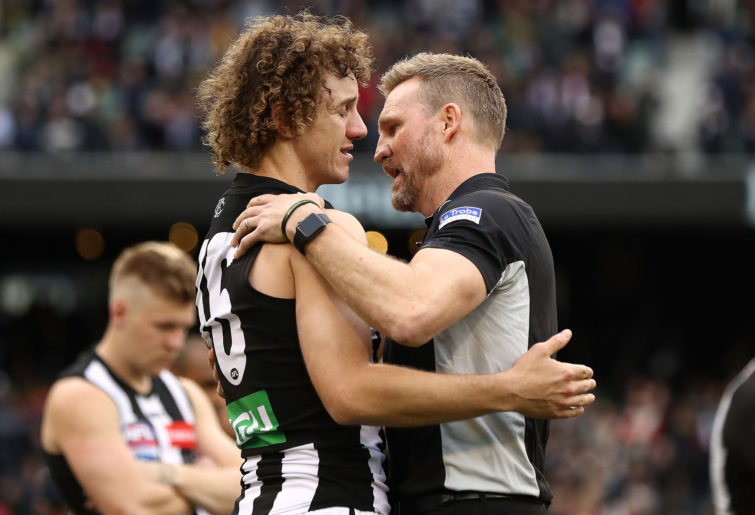
(Photo by Ryan Pierse/AFL Media/Getty Images)
Supporting a club is like being in a long-term relationship. There are times your partner will upset, anger, frustrate, sadden, confuse, bemuse, stun and blindside you. But, generally, you keep moving forward – well, as best as you can.
I decided in coming up with a list, I’d have to exclude grand finals and finals in general. Grand finals would occupy a top 20. The list had to be drawn exclusively from home-and-away games or off-field events.
I’m also going to exclude should-haves, like they should have drafted Patrick Cripps. Collingwood were not the only club to overlook Cripps. He’d be a should-have for every other club who picked somebody else before him.
All the choices have to be rooted in fact in some way.
Also, all these choices are based on how I felt at the time they happened. Not one of these is retrospective wisdom.
Instead of a top ten, I went for 15 – one for every Collingwood flag.
15. Trading for Gary Pert
I’m going to start off with a simple one that’ll offer some context on my other choices going forward.
I’m not big on sentimentality in the AFL. I understand players are commodities, and clubs are always searching for a way to improve their stocks. I do believe in loyalty, although it’s becoming an obsolete component of the game. I’m also a believer that given list sizes, you can afford to be speculative at the lower end of the list when draft choices are extreme long shots.
In terms of list acquisitions, I always qualify decision through a series of questions.
Do we need that player? Or, if we’re trading somebody out, can we afford to lose them? What’s their upside? Are they being traded for too little? Is the club paying too much? Would it be better to retain a player and gamble on their productivity, rather than take some recycled alternative, or a young option who’s an extremely low pick with the odds against them?
Gary Pert had been an elite fullback for Fitzroy – one of the best in the league. At the end of 1990, he injured his knee – his second serious knee injury, the first being in 1987. Fitzroy, struggling financially, let him go. Pert missed all of 1991, and came to Collingwood in 1992.
Did they need him? Well, I guess that’s debatable. Obviously, you always have room in your side for an elite player in any position, but Pert’s knee injuries had seriously hurt his speed and mobility. They were a great example of how injuries can level a player, and prohibit them from playing as they used to. I’m sure everybody can think of examples this has occurred to.
At this time, Collingwood had premiership duo Craig Kelly and Michael Christian as their key defenders, as well as Ron McKeown. They had young guys coming up in Mark Richardson and Jason McCartney. They had a couple of other young talls in the reserves. They mightn’t have amounted to much ultimately, but at the time they looked genuinely exciting prospects.
I never understood the recruiting of Pert. It was stockpiling talls when they had that area covered. Pert offered solid service, but was never the player he was at Fitzroy. Him being on the list pushed the younger Ron McKeown out of favour. McKeown would leave at the end of 1993, despite being only 26. To be fair, there were other things going on in McKeown’s life that might’ve contributed to this decision.
Just a year earlier, Collingwood had drafted the retired Gerard Healy with their last pick, just in case he decided to play on. He didn’t.
A year later, they drafted Sydney’s Barry Mitchell (father of Tom), seemingly just to stop him from getting to Carlton. At that time, Collingwood had a fast and stacked midfield, and Mitchell ended up spending big portions of his Collingwood career on the bench and in the reserves.
I remember one headline (from Round 2, 1993) that Collingwood could fit Mitchell in their cap, but not in their team on the ground. This was before rotations, and players could spend long stretches on the bench.
The reason I hang on the Pert decision is that it exemplifies that the administration of the club that had built the 1990 premiership through stringent financial practices, identifying needs and targeted recruiting were now approaching the game with a certain extravagance.
14. Trading for Dayne Beams
I had no problem in trading for Dayne Beams if he came cheaply, like a single first-round pick, but I thought the cost of two first-round picks was just too high. He was a 29-year-old who’d used his body as a battering ram for the bulk of his career. I did not foresee a long career for Beams – especially one that would go the four years Collingwood signed him to.
I understand his last couple of seasons for the Brisbane Lions had been brilliant, but trading should be a needs-based strategy.
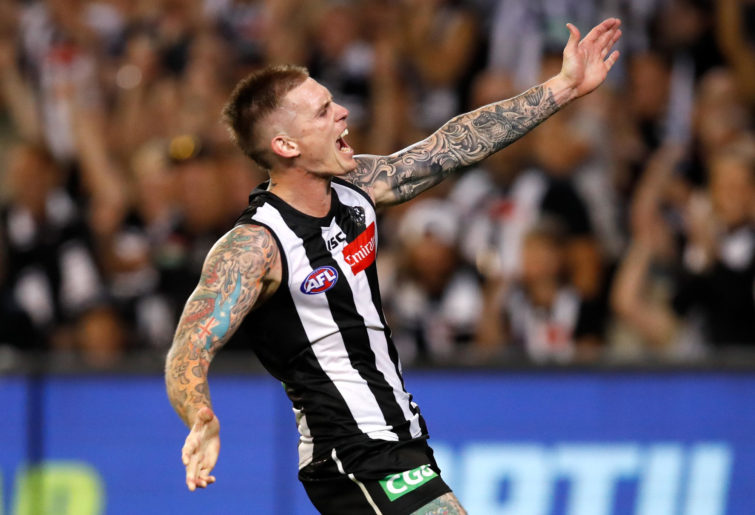
(Photo by Dylan Burns/AFL Photos)
I didn’t walk away from the 2018 grand final loss thinking Collingwood were missing somebody like Dayne Beams. They were missing a genuine key position player – particularly in defence – who could be part of their short, medium and long-term plans. They were missing a genuine key forward. They were missing a wily crumber like Leon Davis or Andrew Krakouer.
They probably banked on the likes of Darcy Moore, Lynden Dunn and Jamie Elliott to return and fill these roles to some extent, but given the injury profiles of Moore and Elliott, plus Dunn’s age, some insurance and planning for the short and mid-term future would’ve been nice. Another mid in a deep, deep midfield was not a priority, but a luxury.
I’m often wrong, but I think a large part of Beams’ trade was politically motivated. He was the latest from the 2010 premiership side to leave for another club – a list that includes Heath Shaw, Dale Thomas, Sharrod Wellingham, Chris Dawes, Nathan Brown and Héritier Lumumba. And he was the latest to leave due to queries about his relationship with the coach – and to that list, you can add Darren Jolly and Alan Didak.
Bringing him back felt like a ploy to show all and sundry that things were good at Collingwood, and that old grievances were no more. It just felt as if everybody got lost in the romanticism of the deal, rather than looking at it realistically.
As an aside, I don’t judge the trade worse now that it looks as if Dayne Beams will retire. Stuff happens in AFL and every trade comes with the implied buyer-beware stamp. But it does frustrate me that signing Beams meant that James Aish was squeezed out just one year later.
Surely they realised the salary cap would be tight given they knew the likes of Brodie Grundy, Darcy Moore, Jordan de Goey, Brayden Maynard and Jaidyn Stephenson would all be asking for pay increases in the very foreseeable future. Why bloat the cap?
13. Delisting Saverio Rocca
Rocca is an underrated full forward in the annals of VFL/AFL history. He kicked 748 goals – 534 of those at Collingwood. On his day, he was unstoppable. Yes, he could be spasmodic with his output, but he was also the full forward in some ordinary teams with some very ordinary game plans and some ordinary delivery. Imagine if he’d been part of Hawthorn’s heyday in the 1980s.
He always seemed to become a scapegoat whenever Collingwood struggled, which was often in those years. It’s always bemused me that when a team’s struggling, when delivery is awful, when forwards are allowed to be triple and quadruple-teamed or blocked, how the ire falls invariably on the forward, like they’re still expected to function in this mess and kick a bag regardless.
Mick Malthouse arrived at Collingwood at the end of 1999 and cut a swath of players. Throughout 2000 he used Saverio sporadically up forward and in the ruck. Then it seemed Malthouse determined he couldn’t afford two big lumbering forwards – in Saverio and his brother Anthony – inside 50, although Malthouse drafted Scott Cummings two years later, so what do any of us know?

Joining the arch rival wasn’t the only thing Mick did to rile Pies fans. (Photo: Greg Ford/AFL Media)
The reality is coaches have to make hard decisions. I’ll accept that Malthouse made the decision that Saverio had to go. But why foreshadow it so clumsily by dropping him to the VFL late in the season, signalling the end of his Collingwood career? Why delist him for nothing?
Given Malthouse was early into a heavy rebuild, why not play Saverio, improve his currency, and shop him around for a trade? Anything is better than nothing – especially given Collingwood were coming off a wooden spoon in 1999, and would finish 15th (out of 16 teams) in 2000.
North Melbourne picked up Saverio in the draft, where he kicked another 234 goals in seven years in another battling team.
12. Trading pick three in the 1999 national draft
Going into Collingwood’s second wooden spoon in 1999, many people talked about the litany of awful plodders Collingwood had on the list. But the nucleus was there for a good side.
The spine included Chris Tarrant, Saverio Rocca, Anthony Rocca, Simon Prestigiacomo, Andrew Schauble, Mark Richardson and Mal Michael. Michael became integral to Brisbane’s three-peat premiership sides. Andrew Schauble won a best and fairest for the Swans. Mark Richardson aside (as his career was winding down), the others had long and successful careers at AFL level.
The on-ballers included Nathan Buckley, Scott Burns, Paul Williams, Paul Licuria, Heath Scotland, Nick Davis and Rupert Betheras. They had experienced players in Gavin Brown, Gavin Crosisca and Glenn Freeborn. So it wasn’t all bleak.
Collingwood finished wooden spooners and earned a priority pick – picks one and three in the national draft, and pick one in the pre-season draft. Josh Fraser was touted as a once-in-a-generation talent. On-ballers Aaron Fiora and Paul Hasleby plus key position players Matthew Pavlich and Leigh Brown were likely to round out the top five.

Pav could have been a Pie. (AAP Image/Tony McDonough)
Mick Malthouse decided Collingwood needed a ruckman, so traded pick three and on-baller Clinton King to Richmond for pick seven and ruckman Steve McKee. McKee gave Collingwood good, solid service, but was he worth sacrificing a pick in the top five?
Collingwood took Danny Roach with pick seven, a player they likened to James Hird. Roach had one game that amounted to about 20 minutes, and that was it. He was gone. It was a pick squandered during a rebuild that led to a premiership assault in 2002.
Maybe the rationalisation is that at that time, the draft was still a speculative thing, rather than the science that it’s almost become.
Still, I would think you’d want the best picks available.
Malthouse might’ve wanted to shield Josh Fraser from ruck duties (which became moot, as Steve McKee missed the first half of 2000 with legionnaires’ disease – only at Collingwood) but he had premiership ruckman Damien Monkhorst there who could’ve taken on that responsibility in the short term. Instead, Malthouse cut Monkhorst.
It seemed odd manoeuvring for the list build.
11. Round 22, 1981 – Collingwood versus Fitzroy
Here we go, back in time to when I was just learning about how Collingwood could frustrate me. For an optimistic kid who saw his team winning regularly, it was an early but hard lesson in disappointment. Now, thanks to Collingwood, I have a masters.
Collingwood sat on top, and just had to beat Fitzroy to become minor premiers. Carlton were second, one win behind Collingwood. On a day it rained for the bulk of the game, Collingwood put in a shocker. Fitzroy upset them to consolidate fifth position in the final five. Carlton beat the sixth-placed Richmond to jump to top position. And Collingwood dropped to second.
The final-five system employed at the time hugely benefited the minor premiers, giving them the first week off from finals, and two opportunities to go straight into the grand final: the second semi-final, and if they lost that, the preliminary final.
Ideally, the minor premier would get the first week off, win the second week (and go into the grand final), get the third week off, and play an opponent coming off three finals in the grand final.
It’s exactly what Carlton did.
Collingwood gave themselves just about the toughest run they could: Geelong beat them in the qualifying final, Collingwood just got over Fitzroy in the first semi, and then just beat Geelong in the preliminary final.
All three finals were exhausting, and in each Collingwood had to try find something to win. Captain Peter Moore also suffered a hamstring injury. Years later, complaints would emerge that coach Tommy Hafey trained them too hard.
Come the grand final, Carlton ran over the top of the Pies in the last quarter.
What might’ve been had Collingwood won that last home-and-away game?
In the coming days, I will reveal my top ten CSM moments.

































































































